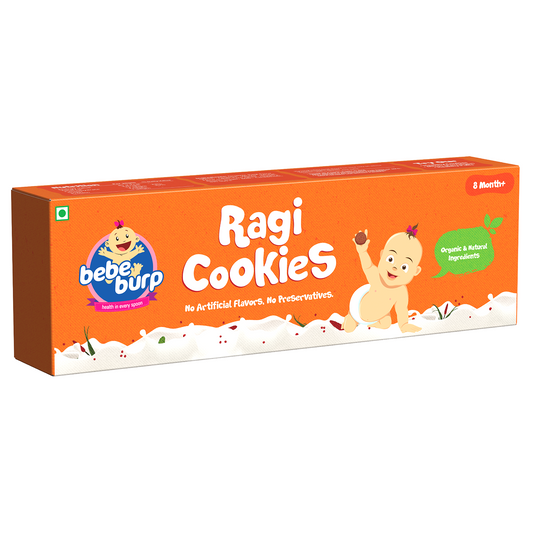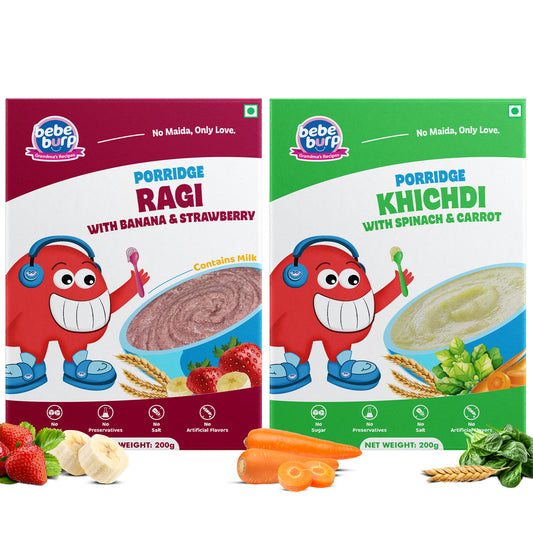Ragi porridge maintains its status as a long-time family staple throughout India because of its nutritious advantages.
Babies who consume ragi (finger millet) can experience the side effects of digestive problems including constipation, bloating, and gas, together with potential allergic reactions in addition to a choking risk, which demands proper preparation, control, and medical approval before giving ragi to your child.
Packed with essential nutrients, ragi—also known as finger millet—is an incredibly nourishing food for infants, offering a wealth of health benefits.
Finger millet brings you vitamins from calcium and iron and antioxidant properties, which enhance bone health and protect your baby's immune system while making it grow faster.
Sensitively managed feeding remains essential even though ragi provides multiple nutritional benefits because it holds specific risks that should be recognized before giving it to babies with sensitive digestive tracts.
Through this complete guide, you will learn about ragi side effects for your baby, followed by expert advice, which will help you follow a safe strategy for including this nutritious food in your eating plan.
Side Effects of Ragi for Babies: What Every Parent Must Know
 Parents select ragi due to its high calcium content, iron, fiber, and other vital nutrients that make it an excellent food for infants.
Parents select ragi due to its high calcium content, iron, fiber, and other vital nutrients that make it an excellent food for infants.
Ragi ingestion can lead to unwanted health complications in specific cases of babies. Side effects from ragi intake occur seldom but some babies experience these reactions.
- Allergic Reactions: Ragi allergens in some babies produce skin rashes besides swelling and discomfort in the body.
- Digestive Issues: Ragi creates digestive problems in babies with delicate digestive systems, resulting in gas, bloating, and constipation.
- Choking Hazard: Preparation mistakes make ragi a choking risk for babies who cannot swallow solids easily.
Before serving ragi to your child, you should start with tiny amounts to detect adverse reactions.
Ragi Side Effects on Stomach: Understanding Digestive Issues
 Ragi contains high amounts of fiber that work well for adults yet create difficulty for baby intestines.
Ragi contains high amounts of fiber that work well for adults yet create difficulty for baby intestines.
Numerous digestive problems like bloating, discomfort, and constipation can develop rapidly from consuming large amounts of ragi.
It is essential to start ragi consumption in small portions due to the developing state of the baby's digestive system.
-
Constipation: Babies cannot easily digest ragi's high fiber content because this creates constipation problems.
- Gas and Bloating: The combination of starch and fiber in ragi produces gas and bloating issues when babies have not yet developed proper stomach tolerance.
Mixed ragi should only be served with water or fruits to improve digestion for babies while you track their reaction to new foods.
Side Effects of Eating Ragi: Important Safety Guidelines
 Ragi represents a nutritious dietary addition for babies but parents must follow to avoid unwanted side effects during food introduction.
Ragi represents a nutritious dietary addition for babies but parents must follow to avoid unwanted side effects during food introduction.
Introduce Slowly: Start feeding ragi to your baby in tiny amounts before identifying their tolerance level. Begin with small portions of ragi then adjust them in portions over time.
Prepare Properly: Your preparation of ragi should include boiling it until it becomes perfectly tender and easily chewable.
Give ragi after thorough cooking since unprocessed grains become problematic for the baby's digestive system to process.
Watch for Allergies: Check for allergic responses, including rashes, swelling, or irritation following ragi introduction.
Seek medical help right away from your pediatrician whenever symptoms appear.
The appropriate way to present ragi to your baby depends on their developmental stage, so prepare it as porridge or mix ragi flour with water.
Ragi Malt Side Effects: Special Considerations for Babies
Many consumers experience side effects when consuming ragi malt, a traditional ragi-based powdered porridge substance. People generally find ragi malt safe but should consider several important points.
Excessive Consumption: Excessergic consumption of ragi malt can result in a complete feeling that may produce digestive issues. Always serve it in moderation.
Sugar Content: Ragi malt products in the market could include additional sugar and preservatives. Read the label first, then choose pure, unsweetened ragi malt products.
Ragi malt provides energy with nutrients yet parents should limit it as an individual food and include other foods to give their baby a balanced nutrition.
How to Minimize Ragi Side Effects in Babies
 People should follow these instructions when they want to reduce the potential side effects of eating ragi:
People should follow these instructions when they want to reduce the potential side effects of eating ragi:
Start Slowly: Malting ragi into your baby's diet requires a steady pace by feeding them tiny quantities to monitor tolerance levels.
Mix with Other Foods: The digestive effects of ragi can be moderated by combining banana fruits and sweet potato vegetables when preparing foods.
Watch for Signs: Watch for discomfort such as fussiness and bloating or bowel movement modifications.
Use Ragi Flour: Seek finely ground ragi flour that has reached the proper cooking temperature to improve digestion.
Over time you can increase the amount of ragi consumption for your baby but ensure no adverse effects on their health.
Expert Tips for Safe Ragi Consumption
 The following expert advice demonstrates how to make ragi consumption safe yet beneficial for your baby:
The following expert advice demonstrates how to make ragi consumption safe yet beneficial for your baby:
Consult a Pediatrician: Your pediatrician should always approve new foods, including ragi when caring for babies with food allergy backgrounds.
Diversify Your Baby's Diet: Despite its nutritious qualities, parents should offer their babies a wide range of foods to absorb all required nutrients.
Keep It Fresh: Fresh ragi should always be your choice since long-shelf-life products lead to reduced nutritional benefits.
Any symptoms of intolerance or allergic reactions to ragi require you to stop giving it to your child and obtain medical advice from a healthcare provider.
To Sum Up
The nutritional benefits of ragi as an excellent food source require a proper introduction to your baby's diet with careful attention to safety.
Introducing ragi to a baby's diet requires caution because digestive upset and choking alongside allergic reactions may occur from improper timing and measuring ragi consumption.
Cross-consultation with your pediatrician, careful attention to discomfort symptoms, and safety protocols will create conditions for your baby to obtain complete benefits from ragi without adverse effects.
A balanced diet with various foods is essential for your baby's overall health






